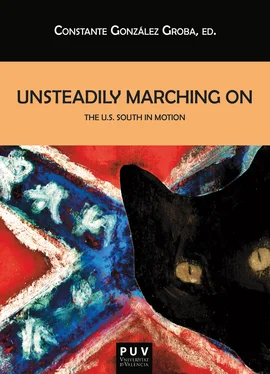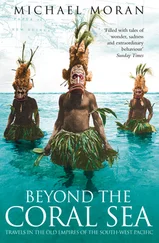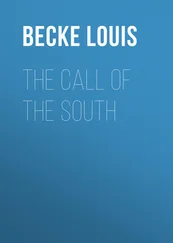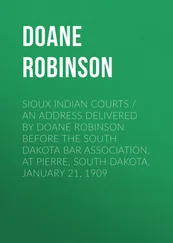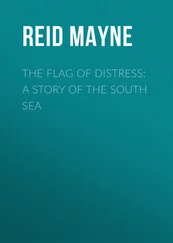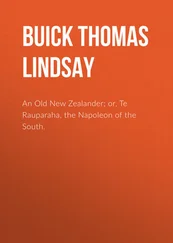Will’s newly acquired freedom as he goes on a trip with Jamie gives him the possibility to choose his destination as Jamie is uncertain about the places he wants to go to: “Jamie was determined to go either out west or to [his sister] Val’s [mission school]” ( LG 274). Will decides on Val but first chooses to go to Sutter’s place in case there is a clue for him there. Indeed, Sutter has purposely left his notebook for Will to learn a lesson: “the dawn of discovery, the imminent sense of coming at last upon those secrets closest to one and therefore most inaccessible, broke over him” ( LG 289).
During the trip, Will keeps wondering where and who he is. As soon as he meets Val, however, his problems seem to be washed away. As she did on their first meeting, when she named Will before even introducing herself ( LG 207), Val calls Will by his name and thus confirms his identity to him ( LG 296) while symbolically giving him admittance into the world of the living. Val presents language as a discovery and, talking about her pupils, she observes: “When they do suddenly break into the world of language, it is something to see. They are like Adam on the first day” ( LG 301). Will admires Val for “the wonderful work [she’s] doing [there]” ( LG 297) and adds, “I’ve always liked Catholics” ( LG 297). This sudden religious attraction—not an accident, knowing Percy’s beliefs—finds an echo in Val’s revelation that Sutter and Jamie have gone to Santa Fe—”Holy Faith” in English. Their destination foreshadows what Will is going to find there, all the more so as the Southwest stands for possibility and abstraction while the Deep South is associated with concreteness and actuality (Lawson, Another 3-21).
However, before Will can proceed on the journey that will give him a chance to have access to “Holy Faith,” he, like “every man[,] has to stand in front of the house of his childhood in order to recover himself” (Percy quoting from Kierkegaard, in Lawson & Kramer 67). On his way to Santa Fe, Will stops at his family house and goes straight to the attic, where past and present overlap and help him visualize his father’s suicide on “the night of [his] victory” ( LG 330). The importance of the attic in Will’s life is made clear: it is where his father shot himself. To Ed Barrett, death was a victory over life because it allowed him to escape the dullness of the everyday and affirm his difference from a world of conformity. As Mark Johnson points out, “The house [...] plays a dual role in the scene, as both the place in which Barrett must confront the memory of his father’s suicide and as the concrete place in which he at last seems to approach some insight into life” (60). Will’s pilgrimage into the heart of his father’s darkness might have taught him something, but at the end of the novel he is still expecting more.
The Last Gentleman pictures Will Barrett as a character who is ready to engineer his life. However, he seems more likely to achieve his goal in The Second Coming , since he has decided to take a journey inward without using a mediator: there is no telescope, that is to say no intermediary between himself and experience, and there is no Sutter to give him clues—he goes into a cave and waits for signs that would justify the worthiness of life. In his biography of Percy, significantly entitled Walker Percy: An American Search , Robert Coles notes:
Through Barrett’s eyes (aided occasionally by the lens of his telescope), the obsessions and pretensions of mid-twentieth-century American secular society, as well as its earnest, decent side, get seen and heard. To a degree The Last Gentleman is a novel of social observation: a character of broad sensibility, both serious and with a sense of humor, travels across a country; the various experiences he has, the accidents and incidents he encounters enable the reader to glimpse what otherwise might go unnoticed. (178)
Indeed with The Last Gentleman Percy explores American history and issues related to race and politics, but he also makes it possible, and this is obviously his main goal, for his character to make sense of his life rather than that of his culture. The aim of the pilgrimage is to bring him salvation, and the one who cannot feel the change would be—to use Percy’s expression—forever “lost in the cosmos.”
Works Cited
Broughton, Panthea Reid. “Gentlemen and Fornicators: The Last Gentleman and a Bisected Reality.” The Art of Walker Percy: Stratagems for Being. Ed. Panthea Reid Broughton. Baton Rouge: Louisiana State UP, 1979. 96-114.
Camus, Albert. L’Etranger . 1942. Paris: Gallimard, 1994.
Coles, Robert. Walker Percy: An American Search . Boston: Little, Brown and Company, 1978.
Emerson, Ralph Waldo. “Nature.” Emerson’s Prose and Poetry . Ed. Joel Porte and Saundra Morris. New York: Norton, 2001. 27-55.
Hicks, Jack. “The Lesions of the Dead: Walker Percy’s The Last Gentleman .” Études Anglaises 32.2 (Avril/Juin 1979): 162-170.
Jarvis, Brian. Postmodern Cartographies: The Geographical Imagination in Contemporary American Culture . New York: St. Martin’s Press, 1998.
Johnson, Mark. “The Search for Place in Walker Percy’s Novels.” The Southern Literary Journal 8.1 (Fall 1975): 55-81.
Lawson, Lewis A. Another Generation: Southern Fiction since World War II . Jackson: UP of Mississippi, 1984.
——. “Will Barrett under The Telescope.” The Southern Literary Journal 20.2 (Spring 1988): 16-41.
Lawson, Lewis A., and Victor A. Kramer, eds. Conversations with Walker Percy . Jackson: UP of Mississippi, 1985.
Percy, Walker. Lancelot . New York: Farrar, Straus & Giroux, 1977.
——. “The Last Gentleman: Two Excerpts from the Forthcoming Novel by Walker Percy.” [Introduction by Walker Percy]. Harper’s Magazine 232.1392 (May 1966): 54-61.
——. The Last Gentleman . 1966. New York: Farrar, Straus & Giroux, 1977.
——. Lost in the Cosmos: The Last Self-Help Book . New York: Farrar, Straus & Giroux, 1983.
——. The Message in the Bottle: How Queer Man Is, How Queer Language Is, and What One Has to Do with the Other . New York: Farrar, Straus & Giroux, 1975.
Pindell, Richard. “Toward Home: Place, Language and Death in The Last Gentleman .” The Art of Walker Percy: Stratagems for Being. Ed. Panthea Reid Broughton. Baton Rouge: Louisiana State UP, 1979. 50-68.
Rosset, Clément. Le Réel et son double: Essai sur l’illusion . 1976, 1984. Paris: Gallimard, Collection « Folio essais », 1993.
——. Fantasmagories suivi de Le réel, l’imaginaire et l’illusoire . Paris: Les Éditions de Minuit, 2006.
Vauthier, Simone. “Narrative Triangulation in The Last Gentleman .” The Art of Walker Percy: Stratagems for Being. Ed. Panthea Reid Broughton. Baton Rouge: Louisiana State UP, 1979. 69-95.
Wyatt-Brown, Bertram. The House of Percy: Honor, Melancholy, and Imagination in a Southern Family . New York: Oxford UP, 1994.
1 According to Rosset, “le réel n’est pas du côté du moi, mais bien du côté du fantôme” ( Le Réel 91).
2 “c’est l’acte même d’éviter le destin qui vient coïncider avec son accomplissement” ( Le Réel 25).
3 The choice of this bird is telling since the novel itself has to do with Will’s peregrinations.
4 The reader is aware that Will suffers from deafness in one ear ( LG 8) and that, as a consequence, his other senses are more acute.
Читать дальше
